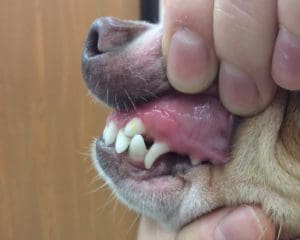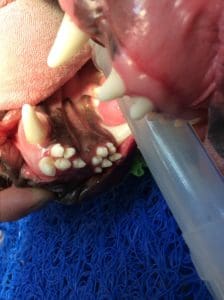All babies, whether human or furry, go through a teething phase where “baby teeth” or deciduous/primary teeth erupt. Puppies normally have 28 deciduous teeth while kittens have 26. The deciduous teeth start erupting through the gums around three weeks of age and typically by six weeks all of the primary teeth are present. Just like humans, pets have 2 sets of teeth: primary and secondary teeth. An adult dog has 42 adult/secondary teeth, while cats have 30 adult teeth.
You may notice your pet “teething.” During this process, your pet may drool, be reluctant to eat as ferociously as before, have some bleeding from the gums, and have a tender mouth. Pets are known for chewing on objects during the teething process. It is important to direct your pet’s chewing towards acceptable and safe objects. In puppies and kittens, the entire teething process is relatively rapid. Teething in puppies begins at about 3.5 to 4 months of age, when the deciduous incisors begin to be replaced by permanent incisors. In kittens, deciduous teeth start erupting at around 3 weeks of age and are normally finished erupting by 6-8 weeks. By 6-7 months, most puppies and kittens will have all of their adult teeth.

As the adult teeth develop, they begin to exert pressure against the roots of the deciduous teeth, stimulating the roots of the deciduous teeth to begin resorbing, thus making room for the budding adult tooth. Should this fail, the adult tooth may move from its normal position, resulting in malocclusion.

The resulting double set of teeth overcrowds the dental arch, causing food to become trapped between the teeth, which may lead to early periodontal disease. A retained deciduous tooth should be extracted as soon as an adult tooth is found in the same area as the baby tooth. No two teeth should occupy the same space. If the extraction is performed early, the abnormally positioned adult tooth usually moves to its normal location. If the deciduous tooth falls out normally, you may not find it due to your pet swallowing it.

The most common persistent teeth (or retained deciduous teeth) are the upper canines, followed by the lower canines and then the incisors. However, any deciduous teeth could be persistent. Persistent teeth are also more common in small breed dogs, and in brachycephalic breeds (dogs with short noses or flat faces), such as Bulldogs, Pugs, Boston Terriers, Boxers, and Shih Tzus. There may also be a genetic predisposition to developing persistent primary teeth as it often occurs in families of dogs.
It is important that your pet’s oral cavity is examined by your veterinarian at their routine exams. The veterinarian makes sure that primary teeth are erupting appropriately, not overcrowding each other or the secondary teeth, and there are no broken teeth or lesions. Due to increased chewing during teething, deciduous teeth may break. This may result in pain, infection, and disruption of the adult budding tooth underneath. It is important to extract any broken deciduous teeth or persistent teeth at the time of spay/neuter to prevent future issues.
Written by: Lindsey G.
1 Image taken from Today’s Veterinary Practice website. No changes made.